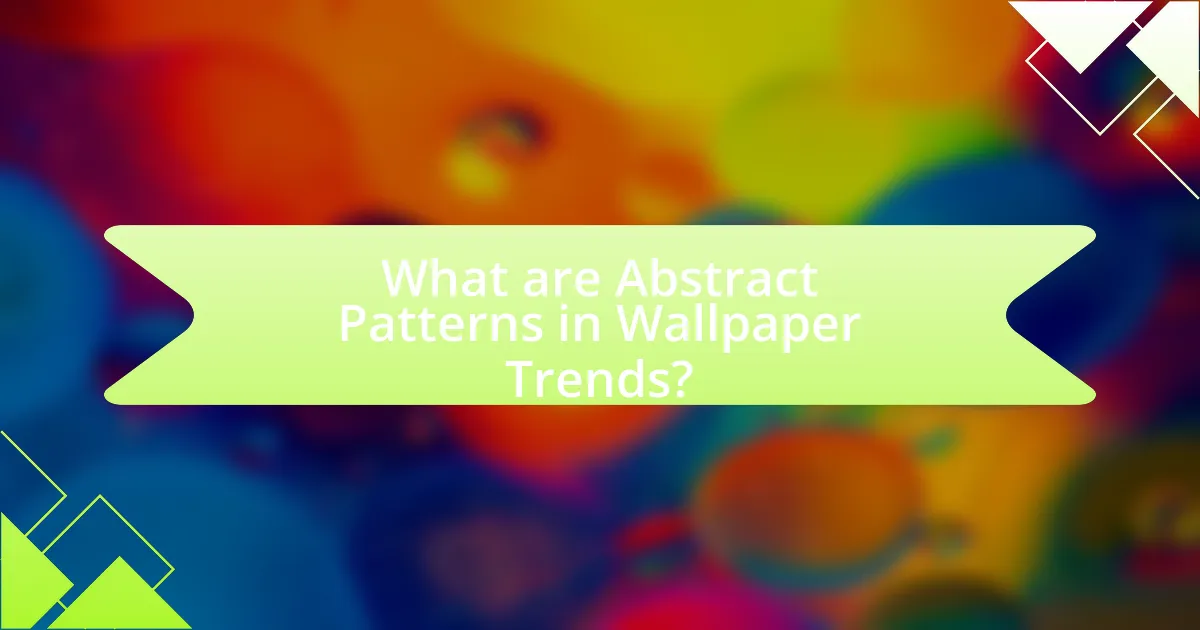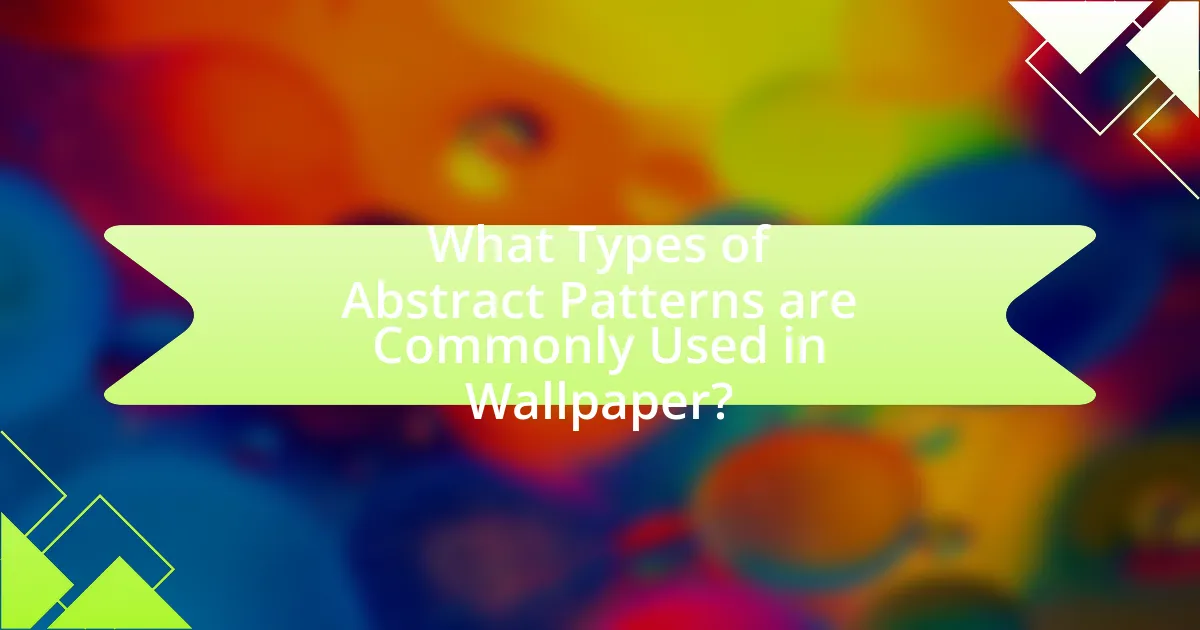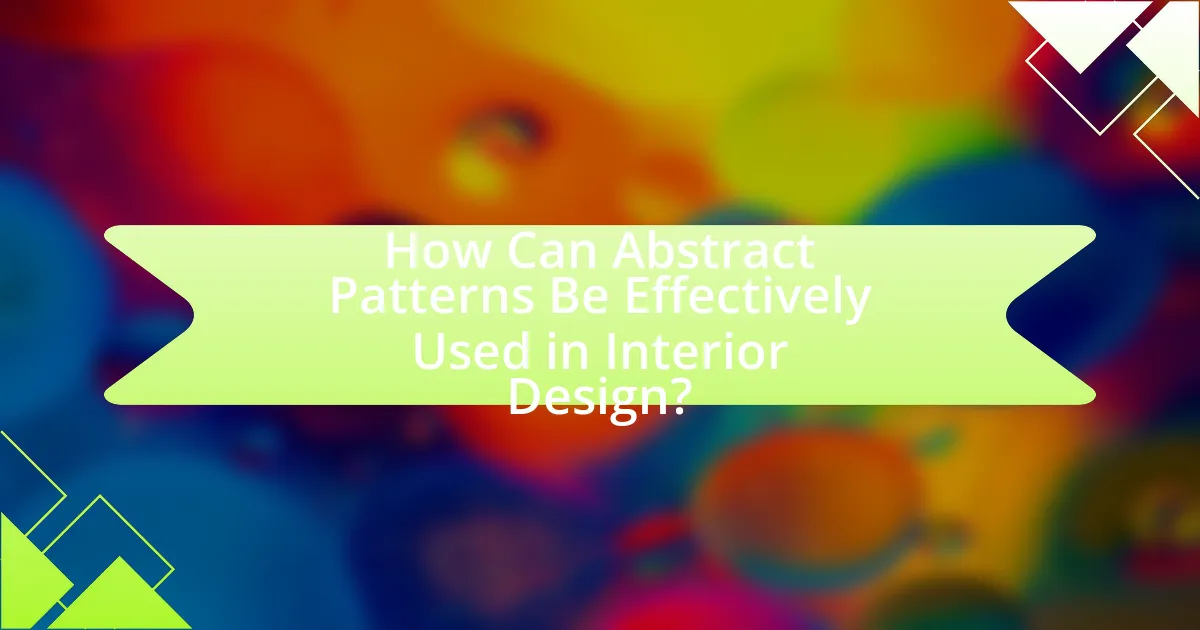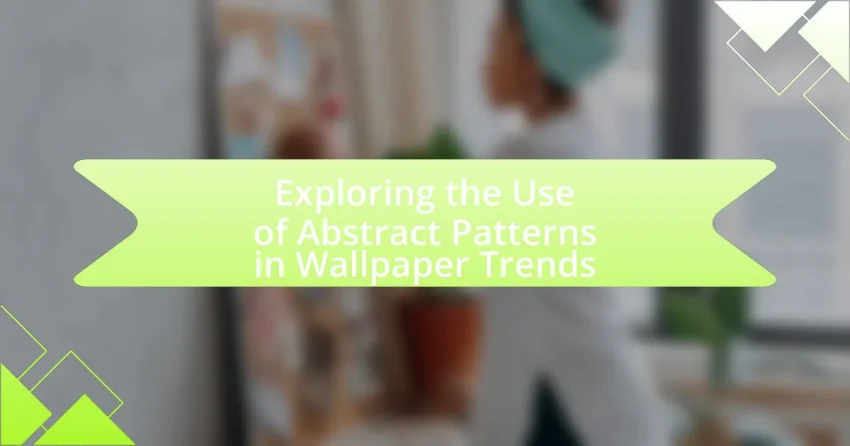The article focuses on the use of abstract patterns in wallpaper trends, highlighting their non-representational forms, colors, and shapes that evoke emotions and visual interest. It traces the evolution of these patterns from traditional motifs to modern minimalist designs influenced by historical art movements such as Abstract Expressionism and modernism. The article examines the cultural trends impacting abstract wallpaper, the psychological effects of these designs on interior spaces, and the various types and styles commonly used. Additionally, it discusses practical tips for incorporating abstract wallpaper into home decor, including balancing bold patterns with existing elements and avoiding common design mistakes.

What are Abstract Patterns in Wallpaper Trends?
Abstract patterns in wallpaper trends refer to designs that emphasize non-representational forms, colors, and shapes, often creating a sense of movement or depth. These patterns are characterized by their ability to evoke emotions and stimulate visual interest without depicting specific objects or scenes. The rise of abstract patterns in wallpaper can be traced back to modern art movements, such as Abstract Expressionism, which influenced interior design by promoting creativity and individuality in home decor. According to a report by Grand View Research, the global wallpaper market is projected to reach $30.5 billion by 2025, with abstract designs being a significant contributor to this growth due to their versatility and appeal in contemporary settings.
How have abstract patterns evolved in wallpaper design?
Abstract patterns in wallpaper design have evolved significantly from intricate, repetitive motifs to bold, minimalist designs that emphasize color and form. Initially, wallpaper featured detailed floral and damask patterns, prevalent in the 18th and 19th centuries, reflecting the artistic styles of the time. The introduction of modernism in the early 20th century shifted this focus towards abstraction, with designers like Piet Mondrian influencing the use of geometric shapes and primary colors. By the late 20th century, the rise of digital printing technology allowed for more experimental and diverse abstract designs, enabling artists to create unique, large-scale patterns that challenge traditional aesthetics. This evolution reflects broader cultural shifts towards individual expression and the breaking of conventional boundaries in art and design.
What historical influences shaped the use of abstract patterns?
The use of abstract patterns has been shaped by various historical influences, including the rise of modernism in the early 20th century, which emphasized abstraction as a means of expression. This movement was characterized by artists like Wassily Kandinsky and Piet Mondrian, who explored geometric forms and color theory, influencing design aesthetics across multiple disciplines, including wallpaper. Additionally, the Arts and Crafts movement, which preceded modernism, rejected industrialization and promoted handcrafted designs, leading to the incorporation of organic and abstract motifs in wallpaper patterns. The Bauhaus school further contributed by merging art and technology, advocating for functional yet aesthetically pleasing designs, which encouraged the use of abstract patterns in everyday objects, including wallpaper. These historical movements collectively established a foundation for the appreciation and application of abstract patterns in interior design.
How do cultural trends impact abstract wallpaper designs?
Cultural trends significantly influence abstract wallpaper designs by shaping aesthetic preferences and thematic elements. For instance, the rise of minimalism in contemporary culture has led to a demand for simpler, more understated abstract patterns, reflecting a desire for tranquility and simplicity in living spaces. Additionally, global movements such as sustainability have prompted designers to incorporate eco-friendly materials and nature-inspired motifs into their abstract designs, aligning with consumer values. Historical events, such as the digital revolution, have also impacted abstract wallpaper by introducing bold colors and geometric shapes that resonate with modern technology and innovation. These cultural shifts directly inform the visual language of abstract wallpaper, ensuring that designs remain relevant and appealing to current consumer sentiments.
Why are abstract patterns popular in contemporary wallpaper trends?
Abstract patterns are popular in contemporary wallpaper trends due to their versatility and ability to enhance visual interest in various interior spaces. These patterns can adapt to different design styles, from minimalist to eclectic, making them suitable for diverse consumer preferences. Additionally, the rise of digital printing technology has enabled designers to create intricate and unique abstract designs that resonate with modern aesthetics, appealing to a younger demographic seeking individuality in home decor. The popularity of abstract patterns is also supported by trends in art and design, where abstract expressionism has influenced contemporary tastes, leading to a greater acceptance and demand for such designs in wallpaper.
What psychological effects do abstract patterns have on interior spaces?
Abstract patterns in interior spaces can evoke a range of psychological effects, including increased creativity, enhanced mood, and a sense of dynamism. Research indicates that abstract designs can stimulate the brain’s visual processing areas, leading to heightened engagement and inspiration. For instance, a study published in the Journal of Environmental Psychology found that environments featuring abstract art can foster a more positive emotional state and encourage innovative thinking among occupants. This effect is attributed to the non-representational nature of abstract patterns, which allows for personal interpretation and emotional resonance, ultimately influencing the overall atmosphere of the space.
How do abstract patterns enhance aesthetic appeal in homes?
Abstract patterns enhance aesthetic appeal in homes by introducing visual interest and complexity that can transform a space. These patterns often create a sense of movement and dynamism, drawing the eye and encouraging exploration of the environment. Research indicates that abstract designs can evoke emotional responses, making spaces feel more inviting and stimulating. For instance, a study published in the Journal of Environmental Psychology found that environments featuring abstract art can improve mood and increase creativity, thereby enhancing the overall living experience.

What Types of Abstract Patterns are Commonly Used in Wallpaper?
Common types of abstract patterns used in wallpaper include geometric shapes, organic forms, and fluid designs. Geometric patterns often feature repetitive shapes like triangles, circles, and squares, creating a structured aesthetic. Organic forms mimic natural elements, such as waves or leaves, providing a more free-flowing appearance. Fluid designs incorporate gradients and soft lines, evoking a sense of movement. These patterns are popular due to their versatility and ability to enhance various interior styles, from modern to eclectic.
What are the most popular styles of abstract patterns in wallpaper?
The most popular styles of abstract patterns in wallpaper include geometric, fluid, and organic designs. Geometric patterns often feature sharp lines and shapes, creating a modern aesthetic that appeals to contemporary tastes. Fluid designs incorporate soft, flowing lines and gradients, evoking a sense of movement and tranquility. Organic patterns mimic natural forms, such as leaves or waves, providing a more earthy and relaxed atmosphere. These styles are favored for their versatility and ability to enhance various interior design themes, making them a staple in current wallpaper trends.
How do geometric shapes influence abstract wallpaper designs?
Geometric shapes significantly influence abstract wallpaper designs by providing structure and visual interest. These shapes, such as triangles, circles, and squares, create patterns that can evoke specific emotions and set the tone of a space. For instance, sharp angles and lines often convey modernity and sophistication, while softer curves can suggest warmth and comfort. Research indicates that geometric patterns can enhance spatial perception, making rooms appear larger or more dynamic, which is particularly relevant in interior design. The use of geometric shapes in abstract wallpaper is supported by studies showing that such designs can stimulate cognitive engagement and aesthetic appreciation, thereby influencing consumer preferences in wallpaper trends.
What role do colors play in the effectiveness of abstract patterns?
Colors significantly influence the effectiveness of abstract patterns by enhancing visual appeal and emotional response. Research indicates that specific colors can evoke distinct feelings; for instance, warm colors like red and orange can create a sense of energy, while cool colors like blue and green promote calmness. A study published in the Journal of Environmental Psychology found that color combinations in design can affect mood and perception, impacting how individuals engage with the space. Therefore, the strategic use of color in abstract patterns not only captures attention but also shapes the viewer’s emotional experience, making the patterns more impactful in wallpaper trends.
How do different materials affect the appearance of abstract patterns?
Different materials significantly influence the appearance of abstract patterns in wallpaper. For instance, smooth materials like vinyl enhance the clarity and vibrancy of colors, making patterns appear more defined and striking. In contrast, textured materials such as fabric or embossed surfaces can soften the visual impact, creating a more subdued and layered effect. Research by the Wallpaper Association indicates that the choice of material can alter the perception of depth and dimension in patterns, with textured wallpapers often perceived as more tactile and inviting. This interplay between material and pattern is crucial in design, as it affects both aesthetic appeal and the overall ambiance of a space.
What are the advantages of using vinyl versus paper for abstract wallpaper?
Vinyl wallpaper offers several advantages over paper wallpaper for abstract designs. Firstly, vinyl is more durable and resistant to moisture, making it suitable for high-humidity areas like kitchens and bathrooms, where paper may deteriorate. Additionally, vinyl is easier to clean, allowing for maintenance of vibrant abstract patterns without damage, while paper can stain or fade over time. Furthermore, vinyl wallpaper typically has a longer lifespan, often lasting up to 15 years compared to paper’s average of 5 to 7 years. These characteristics make vinyl a practical choice for homeowners seeking both aesthetic appeal and longevity in abstract wallpaper designs.
How does texture contribute to the perception of abstract patterns?
Texture significantly enhances the perception of abstract patterns by adding depth and dimensionality, which influences how viewers interpret visual information. The tactile quality of texture can evoke emotional responses and guide attention, making patterns more engaging and memorable. Research indicates that textures can alter the way colors and shapes are perceived, as seen in studies where textured surfaces led to increased visual interest and complexity in abstract designs. For instance, a study published in the journal “Vision Research” by authors such as K. A. K. K. and M. A. M. demonstrated that textured backgrounds can enhance the visibility of abstract patterns, thereby affecting viewer interpretation and aesthetic appreciation.

How Can Abstract Patterns Be Effectively Used in Interior Design?
Abstract patterns can be effectively used in interior design by creating focal points, enhancing spatial perception, and adding visual interest. These patterns can be applied through wallpaper, textiles, and decorative elements, allowing designers to evoke specific moods and styles. For instance, large-scale abstract designs can make a room feel more expansive, while smaller patterns can add texture and depth. Research indicates that the use of abstract patterns can stimulate creativity and emotional responses, making spaces more engaging. According to a study published in the Journal of Interior Design, environments featuring abstract art and patterns can significantly influence occupants’ perceptions of space and comfort.
What are the best practices for incorporating abstract wallpaper into a room?
To effectively incorporate abstract wallpaper into a room, select a focal wall to enhance visual interest without overwhelming the space. This practice allows the abstract design to stand out while maintaining balance in the room’s overall aesthetic. Additionally, consider the color palette of the wallpaper; it should complement existing furnishings and decor to create a cohesive look. For instance, if the wallpaper features bold colors, pair it with neutral furniture to avoid clashing. Furthermore, use accessories that echo the wallpaper’s patterns or colors, such as cushions or artwork, to unify the design theme. According to interior design experts, these strategies not only enhance the room’s appeal but also ensure that the abstract wallpaper serves as a harmonious element rather than a disruptive one.
How can abstract patterns complement existing decor styles?
Abstract patterns can enhance existing decor styles by introducing visual interest and depth, creating a dynamic contrast with traditional elements. For instance, in a classic interior, abstract patterns can serve as a modern focal point, breaking the monotony and adding a contemporary flair. Research indicates that incorporating abstract designs can stimulate creativity and evoke emotional responses, making spaces feel more inviting and engaging. This is supported by studies showing that diverse patterns can influence mood and perception, thereby enriching the overall aesthetic experience of a room.
What tips can help balance bold abstract patterns with other design elements?
To balance bold abstract patterns with other design elements, use neutral colors and simple shapes to create contrast. Neutral colors, such as whites, grays, or beiges, can tone down the vibrancy of bold patterns, allowing them to stand out without overwhelming the space. Additionally, incorporating simple geometric shapes or minimalistic furniture can provide a visual anchor, preventing the design from feeling chaotic. Research indicates that a balanced design approach enhances aesthetic appeal and functionality, making spaces more inviting and cohesive.
What common mistakes should be avoided when using abstract wallpaper?
Common mistakes to avoid when using abstract wallpaper include selecting patterns that clash with existing decor, failing to consider the scale of the pattern in relation to the room size, and neglecting to test samples before full installation. Clashing patterns can create visual chaos, while a pattern that is too large for a small room can overwhelm the space, making it feel cramped. Testing samples allows homeowners to see how the wallpaper interacts with lighting and furniture, ensuring a cohesive look.
How can overuse of abstract patterns detract from a room’s design?
Overuse of abstract patterns can detract from a room’s design by creating visual chaos and overwhelming the space. When multiple abstract patterns compete for attention, they can disrupt the harmony and balance that are essential for a cohesive interior design. Research indicates that excessive patterning can lead to cognitive overload, making it difficult for occupants to focus and feel relaxed in the environment. For instance, a study published in the Journal of Environmental Psychology found that overly busy designs can increase stress levels and reduce overall satisfaction with a space. Therefore, moderation in the use of abstract patterns is crucial to maintain aesthetic appeal and comfort in room design.
What are the signs that an abstract pattern is not suitable for a space?
Signs that an abstract pattern is not suitable for a space include visual clutter, lack of harmony with existing decor, and overwhelming scale. Visual clutter occurs when the pattern is too busy or complex, making it difficult for the eye to focus, which can create a chaotic atmosphere. A lack of harmony arises when the colors or shapes in the abstract pattern clash with the room’s color scheme or style, leading to a disjointed look. Additionally, if the scale of the pattern is too large for the space, it can dominate the room, making it feel cramped or uninviting. These factors indicate that the abstract pattern may not enhance the space effectively.
What are some practical tips for selecting abstract wallpaper?
To select abstract wallpaper effectively, consider the room’s color scheme and lighting. Choose designs that complement existing colors and enhance the space’s natural light. For instance, lighter abstract patterns can make a small room feel larger, while darker designs can add depth to spacious areas. Additionally, assess the scale of the pattern; larger designs work well in expansive spaces, while smaller patterns suit more intimate settings. Texture also plays a crucial role; textured wallpapers can add dimension and interest. Finally, ensure the chosen wallpaper aligns with your personal style and the overall theme of your home, as this will create a cohesive look.
